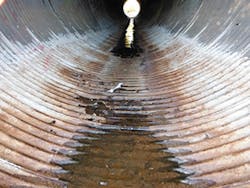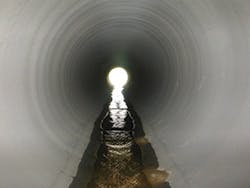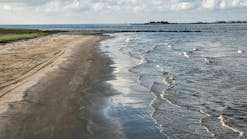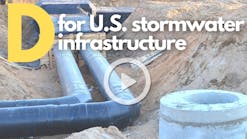A recent California Department of Transportation (Caltrans) stormwater pipe repair project his company executed in California symbolizes two issues faced nationwide in drainage pipe and repair, points out Scott Odell of Michels Pipe Services.
One is that government entities look to extend the life of drainage systems for the longest time possible with the least expense and disruption, including the disruption that comes with digging up and replacing the pipe.
Another: “There are countless drainage issues on every single highway that are rarely looked at,” notes Odell, western regional manager for Michels, a utility contractor based in Brownsville, WI. “Caltrans does a phenomenal job in doing these types of projects and doing condition assessments, so they know they need to replace these liners,” he adds. “If more transportation departments did this, there would be fewer sinkholes and washouts in the roads.”
In September and October 2015, following a pipe inspection, Michels Pipe Services performed a cured-in-place pipe (CIPP) lining project for Caltrans in and around Junction House, CA—an unincorporated community in Nevada County at an elevation of 4,363 feet.
Some 21 different culverts measuring 18 inches by a total of 1,160 linear feet had to be lined, as well as another measuring 24 inches by 210 linear feet. “The reason they were doing these storm lines is because there was a lot of deterioration in them,” says Odell. “There was eroding of the bottom sections where there was no pipe there whatsoever. A subcontractor did some concrete work to fill those voids, and then we’d go in and line the pipe” to make it structurally sound.
Odell estimates the corrugated metal pipe to have been between 20 and 40 years old.
There were some challenges. Work was limited to daylight hours, there was limited space for setup and installation, and the work was being done in a remote area on a two-lane state highway with steep embankments. “We were battling weather coming in,” notes Odell. “It’s in the Sierras, and weather comes in at a moment’s notice. There could be snow the next day. Things had to move quickly on the project.”
Disruption to the environment—which can also be a factor in traditional dig-and-replace operations—was another concern. “Lining versus dig and replace is much easier on the environment,” points out Odell. Even so, the project entailed subcontracting a biologist to monitor the Sierra-Nevada yellow-legged frog, California red-legged frog, and migratory and non-game birds.
The 24-inch liner had to be non-styrene based resin to protect the wildlife in a year-round spring. The job entailed diverting the spring water from the inversion point in lay-flat hoses along the highway, through another culvert drain pipe 900 feet away, and back to the outlet of the 24-inch pipe being lined to keep the stream running at all times during lining operations.
Odell points out that one of the major decisions in using a CIPP repair approach centered on how fast the lines could be put into service. “Instead of digging up the lines, which would take a week or more for each line segment, we were able to do anywhere from one, to three liners per day,” he says. “It involved minimal impact to the traffic and a minimal timeframe.”
The project involved resins from Interplastic Corporation, which manufactures thermoset resins, polyester resins, and vinylester resins used in the CIPP process. The company also manufactures resins used for centrifugally cast pipe and filament-wound pipe, also used in a trenchless process, notes Kaleel Rahaim, business manager for Interplastic Corporation.
“Trenchless methods are generally less expensive than digging in place when it comes to renovating the pipes,” says Rahaim. “The cost is generally significantly less. You don’t have to take the time or use the equipment and the labor needed for digging in place.”
One of the most significant benefits of utilizing trenchless methods for pipe renovation is the “significantly reduced social impact,” notes Rahaim. “Streets and sidewalks aren’t shut down. Businesses aren’t interrupted, and the timeframe for renovating a section of pipe is generally anywhere from one-tenth, to one-twentieth the time it takes to do a dig-in-place.”
Once a problem is pinpointed through inspection, choosing a repair approach is based first on establishing whether a particular process can repair the line and any problems it might have, notes Rahaim. “If a line has a significant amount of defects without any offset joint defects, is in a fairly straight line, and has non-radical curves, then it leaves open several different possibilities,” he says. Those possibilities include slip-lining, pipe-bursting, and CIPP.
“The condition and the configuration of the pipe is critical in determining what types of methods are available that can work in that pipe section,” says Rahaim. “Some pipes are in such a condition that no method will work. You’re going to have to dig and replace. Those situations are becoming rarer as different trenchless methods start evolving to the point of being able to take on more liners in more pipes in various degrees of deterioration.”
Environmental considerations are becoming more important for many projects such as this one. In the CIPP process, styrene in resins is common, he says, adding that most of the resins his company manufactures are safe to use. Interplastic manufactures a “green” resin designed for environmentally safe repair of partially or fully deteriorated underground pipes. The new resins have been used in gravity pipelines and are designed for consistent quality and high strength.
The company’s ECO series resins contain no styrene, no volatile organic compounds, and no hazardous air pollutants and meet the requirements of ASTM F1216, Standard Practice for Rehabilitation of Existing Pipelines and Conduits by the Inversion and Curing of a Resin-Impregnated Tube. They are designed to reduce the likelihood of stress cracking and shrinkage.
Point Repair
Jason Klaus, global sales manager for HammerHead Trenchless Equipment, notes that trenchless solutions are not only cost-effective, but also have the potential to extend the life of a pipe approximately 50 years, as well as increase flow capacities.
Municipalities also can use sectional point repair for existing pipes that have deteriorated sections, joint separation, offset joints, or root intrusion, as well as for sealing connections. Once it’s identified that an area needs repair, there are factors to consider in rehabilitating or repairing the pipe, which include its condition, the host pipe material, the depth of the existing pipe, surrounding utilities or structures, and the length of repair, says Klaus.
While cost of rehabilitation or replacement varies by project, “we believe trenchless methods save money and reduce the risk of damaging surrounding utilities,” he adds.
Such was the case in a recent project in which HammerHead Trenchless—which recently acquired RS Lining Systems to offer umbrella services—was involved. The project entailed stopping a 2-inch stream of infiltration in a 36-inch line in Cedar Rapids, IA, on which a Roto-Rooter Plumbing and Drain Service crew was working.
“They were lining the 36-inch pipe but had too strong of infiltration to line this spot without washing the resin off the liner,” says Jarren Halstead, HammerHead’s regional manager for rehab and replacement. “The only way to hold the water back without digging was to install a 36-inch point repair. Our point repairs are a structural fiberglass and silicate resin repair. It was our best option. We cleaned the pipe and took our measurements.”
Because it was a warm day, crews had to be quick with the wet-out process, notes Halstead. “We wet the glass out, attached it to the packer, and had it in the manhole, which was 23 feet down,” he says. “We then we winched it 180 feet down the line to the repair. We inflated the packer to 12 psi for three hours. When we removed it, the infiltration had stopped and they could then line through it.”
Temperature Matters
Mark Hallett, vice president for Saertex—which manufactures glass fiber, ultraviolet-cured CIPP liners, including the Saertex-Liner—points out that storm drains and storm pipes are different from sanitary sewers in that “they can have a significant environmental impact in the surrounding area. One of the major items to consider is the environmental aspect to using a technology.”
That’s because most storm drains discharge into some type of water body, he adds. “The last thing they want to have happen is to pollute the environment around it and have a fish kill,” he says. “That needs to be identified first: Is it or is it not an environmentally sensitive application? If it is, they have to take into consideration the type of technology they’d like to use to rehabilitate the pipe.”
Hallett contends UV-cured liners “are the most environmentally safe technology available today. The technology cures the liner, so you pull the liner into place, inflate it with air inside the pipe, and cure it with UV light. This is what we call a dry cure—there is no hot water or steam necessary to cure the liner.”
That’s in contrast to the more traditional CIPP approach using hot water or steam to cure the liner. “At some point, this hot water and steam residual water has to be discharged from the liner, and more often than not, the superheated water is just dumped into the stream, carrying typically styrene-laden water with it,” says Hallett. “That combination can not only contaminate the surrounding area, but also potentially cause a fish kill. It can potentially contaminate vegetation in the area, and there’s a concern that the native animals that live in the area could eat this greenery that’s contaminated.”
He says, “We did a project for the state of New York on Whiteface Mountain in late 2015 where the environment was the most important aspect of choosing a technology. They were doing a rehab project for the road that leads to the top of the mountain for the tourists. In addition, they wanted to repair 60 culverts, all of which were directly discharging into a very popular trout stream. They did not want to have any chance of contamination from other technologies, so they used the UV technology exclusively for that reason.”
Hallett agrees that in road transportation projects, more thought needs to be given to drainage aspects. “They are more interested in bridges, asphalt, and guard rails, and even though they have thousands of culverts that cross the highways, it’s really an incidental to them,” he says. “But now this incidental is causing lots of problems because the pipes are failing and they’re having sinkholes in the middle of the highway.”
Aurora, CO, pipe before repair
The state of Vermont, for example, had been using trenchless technologies, but it wasn’t until a recent road collapse on a main highway running north to Canada that consideration was given to a UV-cured liner offered by Saertex, says Hallett. “They had to do an emergency repair, and it was for that reason and because of the environmentally sensitive area that they used the product. It has been their preference since then,” he adds.
Choosing the Best Option for the Site
Channeline offers a full structural lining system for large-diameter non-circular culverts, sewers, and wastewater pipes. “It’s effectively a new pipe within the old pipe,” notes Andy Sherwin, technical sales manager for North America for Channeline. “It’s precured, so there’s no processing onsite. It’s all preformed and ready to go.”
The Channeline product consists of a stiff, strong panel with a relatively thin wall. Unlike the standard grout-in-place or filament-wound liner, the product has a sandwich-like structure. A corrosion barrier on the inside surface is followed by a layer of silica and resin, and then an outer skin consisting of engineered fabric and resin.
When choosing an approach to deal with a pipe repair or rehab job, Sherwin says, “There are many systems on the market that can all do the same thing. It’s a matter of selecting the right technology for the job. I’m a firm believer in there are many technologies, all of which have a niche. Not one product or technology fits all.
“But if there’s an environmental impact—a river, lake, or fish-bearing creek or wildlife around the area itself—then resin can hold toxins, which can kill wildlife. Our system is completely inert when it arrives onsite.”
A consulting engineer who knows trenchless technology and has a good database of available technologies can help sort everything out, notes Sherwin.
Whether it’s more cost effective to do a trenchless repair depends on the field parameters, he notes. “If a culvert, road crossing, or municipal sewer is an area that is not going to be disrupted by an excavation, an excavation sometimes is a cheaper option,” he says. “If a sewer or a culvert is very deep or runs under an arterial road or a highway and there’s going to be major social disruption as well as environmental disruption; that’s really when the trenchless technology systems come into play, because, although you may need a small excavation for insertion of the liner, it is going to be small rather than an open trench.”
A Comprehensive Plan in Colorado
Like most underground infrastructure, stormwater pipe is “out of sight, out of mind,” notes Steve Salazar, P.E., associate vice president for Wilson and Company Inc., engineers and architects in Denver, CO. However, “with water or sanitary sewer transmission systems that are under pressure, when you get a leak or a failed joint, you typically know that because you lose water pressure,” he says. “On a storm drain line, it could be dry because it doesn’t rain. Then you get a large storm event that runs through Colorado. There are large floods within these pipes and it starts to undermine all of that material. This is where we get sinkholes.”
Like many municipalities, the city of Aurora, CO, sought to rehabilitate its corrugated metal pipe (CMP) in a cost-effective fashion that would not disrupt the public. The solution was primarily trenchless.
“They’re saving a lot of money, and the corrugated metal pipe now serves as a host pipe for the rehabilitation method chosen,” says Salazar.
The city engaged Wilson & Company in 2013 to perform a comprehensive condition assessment of 10 miles of Aurora Water’s CMP stormwater infrastructure, ranging in size from 18 inches to 120 inches in diameter.
Aurora Water is responsible for all of the water, sanitary sewer, and stormwater infrastructure for the city, which is Colorado’s third largest with a population of 347,000. “Over time, a lot of the inverts—if they are submerged or receive a lot of water—actually start rusting out and deteriorate,” says Salazar.
That creates a condition in which water that is supposed to flow through the pipe infiltrates underneath the bedding and starts to erode, and then the pipes fail, he explains. Magnesium chloride, used for deicing roadways, is one factor affecting both metal pipes as well as the pH in soils, notes Salazar.
In Aurora, crews inspected and assessed some 323 conduits totaling 41,449 linear feet out of 478 conduits totaling approximately 65,800 linear feet. The in-service and abandoned pipe ranged in size from 12 inches to 120 inches. The majority of the pipe being inspected had been in use for 25 to 40 years.
For a variety of reasons, not all conduits were inspected. Some had been mislabeled in GIS or storm drain maps; some were made of a different material such as concrete or high-density polyethylene. Some were owned or permitted by someone other than the city of Aurora; others were abandoned and inaccessible.
Wilson & Company began the assessment by reviewing data from various sources, such as the city of Aurora and Arapahoe County. Storm drainage, traffic control surveys, GIS data—aerial imagery, storm sewers, contours, utilities, buildings—soil surveys, and various maps were some of the data resources they used. Then crews performed field and video inspections.
All CMP infrastructure assessed is located in Aurora’s developed areas within 15 sub-basin watersheds.
The infrastructure assessed includes CMP storm conduits and 482 related structures such as inlets, manholes, outlet structures, and junction boxes.
Field inspections by man-entry method were conducted from September 30 to October 18, 2013, on the CMP and stormwater infrastructure larger than 48 inches in diameter.
Smaller structures were inspected from October 21 through December 11, 2013, by Wilson and Company crews, with assistance from Quality Pipe Services, a closed-circuit television (CCTV) subcontractor. The inspections consisted of visual observations to identify deficiencies, as well as photo documentation.
Among the infrastructure deficiencies discovered: rusting along the invert or flowline; electric, cable, gas, water, or sanitary lines through the CMP; deterioration due to a chemical reaction with the soil; punctures, holes, or joint separations causing voids to form outside the conduit; alignment changes without access points; sediment or debris buildup and standing water; scour at channel inlets and outlets; and clogged grates or curb inlets.
Wilson and Company developed condition rating and prioritization ranking systems based on the kind and degree of problems and worked with the city to adjust the system for its needs.
Each conduit was evaluated and rated based on the criteria of minor to moderate to significant presence of rust; punctures; deflection, deformation, or joint damage; flow obstructions; and voids.
The ranking was enhanced using additional considerations and corresponding prioritization points, and the conduits were assigned a total prioritization score based on overall condition and additional prioritization considerations. Based on the ranking, a capital improvement program was developed for the city’s CMP Rehabilitation Initiative, based on completing the program in 15 years, with some construction or rehab projects completed each year and an annual budge of approximately $1 million. The total program to replace or rehabilitate 41,000 linear feet of CMP is $20 million.
The capital improvement program was developed by grouping and prioritizing projects with the primary emphasis on condition and prioritization rating, but with secondary emphasis on geographic location. Grouping in this fashion minimizes mobilization and administrative costs for contractors, and projects are sized so that any one grouping’s or project’s cost is approximately $500,000 or $1 million to fit within the annual budget goal of $1 million, notes Salazar.
Other costs are associated with rehabilitation. “It’s not just digging out that pipe and replacing it,” says Salazar. “You have to replace landscaping, curb and gutter, sidewalk, roadway, and other surface improvements, while maintaining access.”
Wilson and Company considered the following rehabilitation methods for the various CMP stormwater infrastructure:
- Remove and replace. This is considered an economically viable option if there are no features above the conduit that add significant cost, but is more disruptive to the public because of traffic disruption for residents and emergency vehicles.
- Centrifugally cast concrete pipe (CCCP). This trenchless technology uses the existing conduit as a form to construct a new centrifugally cast concrete pipe with fiber reinforcement. The process uses high-strength, corrosion resistant mortar for structural renewal of pipe from 30 inches to 120 inches in diameter. It is applied centrifugally or pneumatically gunned for conduits, manholes, and inlets. In Aurora, CCCP was considered the most cost effective for conduit diameters 48 inches and larger.
- Cured-in-place pipe (CIPP). This trenchless technology uses a resin-saturated coated felt tube pulled through the existing pipe. The resin is cured with hot water or steam to construct a new pipe within the existing pipe. CIPP is used for storm conduits ranging in size from 6 to 96 inches in diameter. The CIPP can be completed through manholes or curb inlet lids for conduits 30 inches or less. For larger conduits, the tops must be removed from the curb inlets to complete the process. “It is not considered cost effective when pipe diameters exceed 36 inches,” says Salazar. “However, very long runs of CIPP liner may result in significantly lower unit costs.”
- Slip lining. This trenchless technology involves lining conduit with a slightly smaller-diameter conduit and filling the void between the two with grout; it is typically used for pipes 18 inches in diameter and larger. “Because this method has a larger negative impact on hydraulic capacity than the other trenchless technologies considered, with no apparent cost benefits, it has not been recommended in this project,” notes Salazar.
- Pave the CMP invert with concrete. This trenchless approach involves fastening welded wire mesh to the CMP corrugation crests along the invert and placing 2 inches or more of concrete over the wire mesh and invert. “This rehabilitation method is not for structural repair; it should not be utilized for conduits with inverts that have corroded to the extent that structural concerns exist and therefore has not been recommended for this project unless coupled with the CCCP rehab method,” notes Salazar.
Wilson and Company recommended installing CCCP in 177 conduits, using CIPP in 150 conduits, and removing and replacing 10 conduits with reinforced concrete pipe.
In one instance, the company observed, through CCTV inspection of a pipe, the bottom of the roadway bed, indicating a severe situation. “There was a CMP conduit that formed a large void due to piping and erosion under a local street, and the CCTV inspection noticed the asphalt roadway bed was exposed. This was a street adjacent to a school, so we shut down the road right there because it received bus traffic and trash truck traffic. It was a problem that was going to happen,” says Salazar. “We closed that road and the crews went out to repair it.”
CCCP was used in the rehabilitation of the two 96-inch conduits requiring immediate action. Materials from AP/M Permaform were used in the process.
AP/M Permaform manufactures the high-strength, centrifugally spun Permacast system, designed to seal and reinforce damaged structures.
It All Starts With Inspection
An effective rehabilitation process begins with an extensive inspection. Factors to consider during the pipe inspection process center on the structural integrity of the existing pipe, such as joint separation, large cracks or fractures, capacity limitations, and flow characteristics, says Klaus.
If a municipality or utility finds that there is a need to rehabilitate a pipe, notes Hallett, “they need to evaluate whether it’s physically possible to rehabilitate with trenchless technology. Most of the time, it’s possible to do a trenchless liner in these storm drains, but in some cases—especially in corrugated metal lines—the lines have collapsed beyond rehabilitation, and then an excavation needs to be made.”
Hallett says that often the first part of a pipe to fail is the invert, or the bottom of the pipe. “That can lead to collapse. It can become a much smaller pipe when there is no hoop strength,” he says. “Sometimes, it’s the crown of the pipe that deteriorates and you end up with a collapse from overhead.”
Sherwin points out that during the inspection process, municipalities are going through a condition assessment process to figure out whether the existing pipe is still structurally sound or deteriorating and, if there is deterioration, what’s causing it. “Is it deteriorating because of ground loading, water loading, or internal factors such as chemical attack, hydrogen sulfide attack, or saltwater attack? Once they’ve determined what it is and the condition of the pipe, they can determine whether they need a fully structural rehabilitation or whether they need a protective coating,” he says, adding that Channeline’s protective coating is a thin coating of chemical-resistant material.
“They need to consider if the pipe is still in good condition apart from the surface being attacked. With a structural liner, they need to determine how long the pipe is going to last in its current state and if they need a standalone liner.”
The pipe inspection process exemplifies how pipe owners are becoming more aware of the importance of asset management, says Rahaim. “Owners are beginning to develop plans to manage underground assets,” he points out. “The first and most important thing is to determine the priority for inspecting pipelines. The priorities can be based upon areas of importance as far as environmental impact, commercial impacts, or any other criteria. Once those are identified as priority areas to investigate, then the owner determines what needs to be done in the way of inspection.”
The simplest method of inspection is to contract with someone to run a CCTV camera through the line for visual inspection, notes Rahaim. “The CCTV industry has gotten extremely sophisticated with cameras that have much greater resolution, can fit into smaller spaces, and can navigate even the roughest of pipes,” he says. “That’s the first step to determine the pipe condition.”
Once the pipe condition is assessed, then the pipe owner needs to weigh the amount of deterioration of the pipe, says Rahaim, adding that the most common method is evaluating based upon risk criteria.
The National Association of Sewer Service Companies offers the Pipeline Assessment Certification Program, a defined method for rating pipelines and the degree of deterioration of those pipelines by location as well as identifying the type of deterioration, he says. “Those rating systems are significantly valuable to owners, because it tends to give the owner and the engineering company an idea as to what kind of conditions the pipe is in and whether it is in imminent need of repair or can be placed on a list to be repaired later,” he adds.
Speaking to the importance of municipalities paying now for a condition assessment or more down the road for unanticipated pipe failure, Salazar points out how one Colorado municipality is being challenged with sinkholes, infrastructure problems, and frequent road collapses. “It does cost more money upfront to get that condition assessment and inspect it right, but it’s more costly for them to send crews out there, remove and replace all of that with concrete pipe, put back the road, put back the landscaping, and do it in an emergency fashion,” he says. “If you do a proactive program through a condition assessment, you assess all of the conditions of the conduits within your city, and then you put a program together to address the deficiencies. At the end of the day, it’s a cost savings, and they’re not having to do emergency fixes on the infrastructure, or just waiting for it to fail.”








